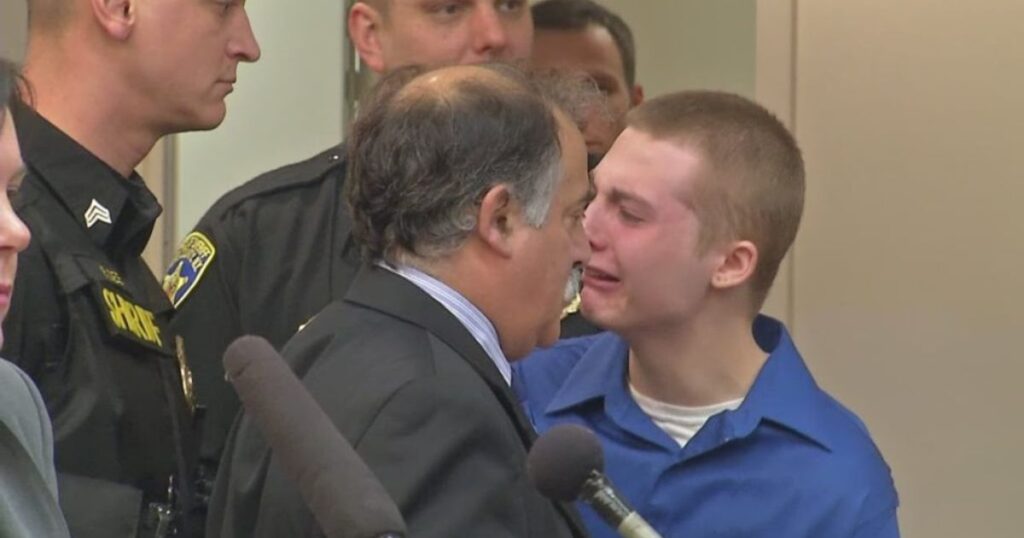Dylan Schumaker is a teenager who gained national attention due to his involvement in a tragic and violent incident. He was convicted of the murder of his girlfriend’s 23-month-old son, an act that shocked many across the country. Schumaker’s case highlighted the disturbing reality of violence, even among young individuals. Despite his age, he faced severe legal consequences and was sentenced to life in prison without the possibility of parole.
This article delves into the details of the case, the legal proceedings, and the psychological factors involved.
A Night of Tragedy
The night of tragedy occurred when Schumaker, then 16 years old, was entrusted with caring for his girlfriend’s toddler, Austin Smith. Reports from that evening suggest that the child’s constant crying triggered a violent reaction from Schumaker, leading to a brutal attack on the defenseless toddler.
Despite the toddler’s vulnerability, Schumaker did not hold back, inflicting fatal injuries that tragically led to the young boy’s untimely death. This night of tragedy left a lasting impact on all those involved and shocked the local community and the nation as a whole.
The Aftermath and Arrest of Dylan Schumaker
Following the tragic incident involving Dylan Schumaker and the death of Austin Smith, the toddler he was caring for, the aftermath was one of shock and disbelief. As the child lay lifeless, Schumaker made a distress call to emergency services. However, suspicions arose quickly as emergency responders noticed the severity of the child’s injuries.
Schumaker was subsequently arrested, and the investigation into the circumstances surrounding Austin’s death began in earnest. The aftermath of this event not only led to the loss of a young life but also raised questions about the safety of children and the responsibilities of caregivers. Schumaker’s arrest marked the beginning of a legal process that aimed to uncover the truth and seek justice for the tragic loss of Austin Smith.
Public Outcry and Trial Commencement of Dylan Schumaker
The arrest of Dylan Schumaker in connection with the tragic death of Austin Smith prompted a significant public outcry and led to widespread shock and disbelief within the community. Many people were horrified by the brutal nature of the crime, especially considering Schumaker’s young age at the time.
The public demanded justice for Austin, and the legal system responded by initiating a trial to determine Schumaker’s guilt or innocence. The commencement of the trial marked a pivotal moment in the quest for justice, as both the prosecution and defense prepared to present their cases and seek resolution for the heartbreaking tragedy that had unfolded. The trial proceedings were closely followed by the public, reflecting the gravity of the case and the widespread desire for accountability and closure.
Read this blog: Now.gg Roblox: Play Roblox Games in Your Browser in 2024
Unraveling the Psyche of Dylan Schumaker

Unraveling the psyche of Dylan Schumaker became a focal point during the trial proceedings. Psychologists and experts were called upon to provide insights into Schumaker’s mental state and the factors that may have influenced his actions. Testimonies and evaluations revealed a complex picture of Schumaker’s emotional stability and upbringing, suggesting potential issues such as emotional instability and a troubled home environment.
The defense sought to portray Schumaker as a product of his circumstances, emphasizing his troubled past and the challenges he faced. However, the prosecution argued that the heinous nature of the crime overshadowed any sympathetic narrative, highlighting the need for accountability and justice.
The unraveling of Schumaker’s psyche shed light on the complexities of human behavior and the factors that can contribute to violent actions, prompting reflection and discussion on the nature of culpability and rehabilitation in cases involving young offenders.
Justice Served
The conclusion of Dylan Schumaker’s trial brought about a sense of closure for many involved in the case. After careful deliberation and examination of the evidence presented, the jury found Schumaker guilty of the charges against him. The judge subsequently handed down a sentence of life in prison without the possibility of parole, reflecting the severity of the crime and the need for justice to be served.
The verdict and sentencing were seen as a vindication of the legal system’s ability to hold individuals accountable for their actions, especially in cases involving such tragic and senseless acts of violence. While the outcome cannot undo the harm caused or bring back the life lost, it serves as a reminder that justice can be pursued and achieved even in the face of unimaginable tragedy.
Community Healing and Legislative Impact
Following Dylan Schumaker’s trial and sentencing, the community affected by the tragedy embarked on a journey of healing and reflection. The loss of young Austin Smith deeply impacted the community, prompting a collective effort to support his grieving family and address the broader issues surrounding child safety and violence prevention.
Community leaders, activists, and local authorities came together to advocate for legislative changes aimed at protecting vulnerable individuals, particularly children, from harm. The case also sparked discussions about the need for stronger laws and resources to address issues related to child abuse and neglect. Through collaborative efforts and a renewed focus on prevention and support, the community aimed to honor Austin’s memory and ensure that similar tragedies could be prevented in the future.
Reflections on the Legal System’s Approach
The case of Dylan Schumaker prompted reflection and discussion on the legal system’s approach to juvenile offenders and violent crimes. Schumaker’s trial as an adult raised questions about the effectiveness and fairness of trying young individuals in adult courts, particularly when considering factors such as age, maturity, and the potential for rehabilitation.
Some argued that treating Schumaker as an adult overlooked his youth and the possibility of addressing underlying issues through juvenile rehabilitation programs. Others supported the decision, citing the severity of the crime and the need for accountability. The case highlighted the complexities of balancing justice, accountability, and rehabilitation in cases involving young offenders and prompted calls for further examination and reform of the legal system’s approach to juvenile justice.
Read this blog: Bluefire Wilderness Lawsuit: An Overview of wilderness therapy
Understanding Violence in Youth
Understanding violence in youth is a complex issue that requires consideration of various contributing factors. Psychological analysis suggests that violent behaviors in young individuals can stem from a combination of environmental, social, and individual factors. These may include exposure to violence or trauma, a lack of positive role models, mental health issues, substance abuse, and socioeconomic disparities. Additionally, certain genetic predispositions may also play a role in predisposing individuals to aggressive behaviors.
Addressing youth violence requires a multifaceted approach that encompasses prevention, intervention, and support. Educational institutions, community organizations, and healthcare providers play critical roles in identifying at-risk youth and providing them with the necessary resources and support systems. Early intervention programs, mental health services, and positive youth development initiatives can help mitigate risk factors and promote healthy behaviors.
Furthermore, fostering a supportive and nurturing environment at home and in the community is essential for promoting positive youth development and preventing violence. Providing young individuals with opportunities for education, employment, and social engagement can help empower them to make positive choices and avoid involvement in violent activities. By understanding the root causes of youth violence and implementing comprehensive strategies for prevention and intervention, communities can work towards creating safer and more supportive environments for all young people.
The Media’s Role in Shaping Perceptions

The media plays a significant role in shaping perceptions and attitudes towards various societal issues, including crime and violence. In the case of Dylan Schumaker, the intense media coverage of the trial and its aftermath had a profound impact on public perception and understanding of the case. While the media serves an important role in informing the public and fostering discussion about important issues, it also has the potential to sensationalize and distort the narrative, leading to misperceptions and biases.
In the case of Schumaker, media coverage raised questions about the ethics of broadcasting a trial involving a minor and the potential for sensationalism to overshadow the facts of the case. Additionally, media portrayals of individuals involved in criminal cases can influence public opinion and contribute to stigma and prejudice.
Moving forward, it is important for the media to maintain a balance between reporting facts accurately and responsibly and respecting the privacy and dignity of those involved, especially when minors are involved. By promoting ethical and unbiased reporting, the media can contribute to a more informed and nuanced understanding of complex issues such as youth violence and the criminal justice system.
Societal Measures for Child Safety
Societal measures for child safety encompass a range of strategies aimed at protecting children from harm and ensuring their well-being in various settings. These measures may include implementing and enforcing laws and regulations related to child protection, such as mandatory reporting of child abuse and neglect, background checks for individuals working with children, and stringent penalties for perpetrators of child abuse.
Additionally, promoting awareness and education about child safety issues among parents, caregivers, educators, and the broader community is essential for fostering a culture of vigilance and accountability. Creating safe environments for children, both online and offline, requires collaboration between government agencies, community organizations, and individuals to address systemic issues and provide support to families in need.
Conclusion
Dylan Schumaker’s case serves as a sobering reminder of the devastating consequences of violent crime and the complexities surrounding juvenile justice. His conviction and sentencing highlight the need for proactive measures to address underlying issues contributing to such incidents, including mental health support and community intervention programs. Moving forward, it is imperative for society to prioritize prevention and support for at-risk individuals to create safer and more compassionate communities for all.










